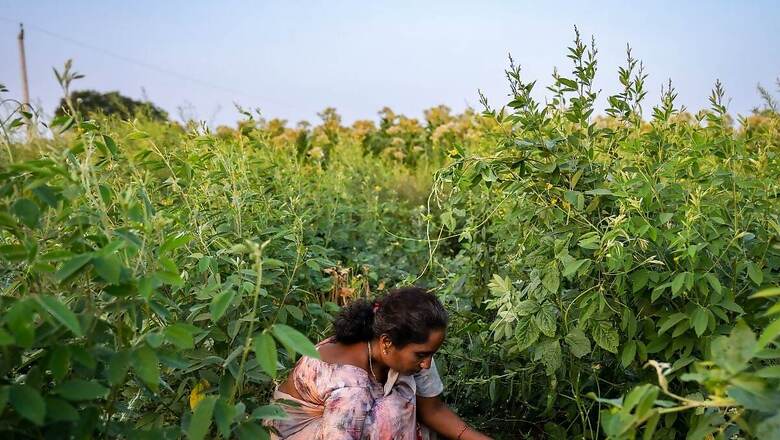
views
Policy planners must acknowledge the tumultuous times shaking the economy’s foundation. Planning cannot be restricted to imagining that the trends are average and standard practices are enough to overcome the emerging troughs that India is facing. There is a job crisis looming ahead. Due to structural changes in the economy, capital generates fewer jobs than it once did in the manufacturing sector.
Artificial intelligence is already changing the job scenario in the services sector. The largest job engine for engineers in the IT sector has delinked top-line growth from new jobs. The agriculture sector is severely impacted by climate change, loss of soil productivity, and water crisis, leading to low margins for farmers. Low margins mean it no longer supports the same number of people on the farm. The combination of climate crisis changing the biosphere and AI changing the work sphere is a meta-crisis.
Policymakers must acknowledge the new paradigm of a meta-crisis. When the job engine faces headwinds, they cannot be addressed by just tweaking existing policies. New thinking is needed to address the impact of this change. The last 12 months have been the hottest in the last 100 years, impacting agricultural production and incomes. The policy has yet to respond to this change.
A new way of thinking means focusing on creating jobs in areas that have yet to be considered, thereby changing the paradigm. This means chasing existing businesses for new job creation will not be enough. But policies to help build new sectors that can create new sets of jobs. It also means changing policies to create enterprises where jobs and skills are at the centre of the enterprise focus. Job-linked incentives have to develop new sectors like cultural and creative enterprises that are more job-intensive.
Cultural enterprises
Culture is seen only as a soft power, and the Ministry of Culture follows this slightly myopic approach of just promoting cultural assets abroad. The Centre for Innovation in Public Policy (CIPP) estimates that cultural jobs could add 1.2 to 2 per cent to the GDP and create up to 12 million cultural jobs. These jobs need to be created in a mission mode, not a ministerial mode, as multiple ministries are involved, and the agenda needs to shift toward jobs. CIPP along with the Network of Indian Cultural Enterprises (NICE) is working on this becoming a priority for Modi 3.0 and has written about it. NICE has been building an ecosystem of cultural entrepreneurs to facilitate their growth and funding.
When we start looking at cultural enterprises in mission mode through a new organisation that can be called the Indian Cultural and Creative Industry Mission (ICCIM), many paradigms of policymaking will evolve differently.
For instance, we must showcase cultural skills for foreign and domestic tourists. Hence, cuisine is one of our oldest cultural assets and needs to be developed as a sector that creates new jobs. To organise the skills in this sector, they need to be recognised, standardised, and certified. This does not need to happen in a traditional bureaucratic manner; it can be done through technology with a cultural stack.
CIPP has been working with several organisations in the digital public infrastructure space to build a cultural stack for the certification and standardisation of cultural skills.
Agricultural model and scaling
The biggest job engine in the country is the agricultural sector. It is being seen as a diminishing or outdated sector because developed countries have moved their workforce out of it into manufacturing and services. Hence, it is assumed that India should follow the same model and move its workforce out of agriculture without understanding the context and contours of such a model or the shift. India has a growing population and burgeoning demographic dividend. It cannot find jobs for its existing graduates in manufacturing and services.
To expect it will shift its agricultural workforce into these sectors is just impossible. CIPP presented the fallacy of assuming that agricultural labour can be moved into other sectors. Now with the climate crisis also hitting the agricultural sector, there is already distress in rural areas.
CIPP has suggested a rethink of the development model for agricultural policies. Assuming that agricultural labour will shift to the services or manufacturing sector, like in other economies, is not going to happen in a populous country like India. The shift from agriculture to manufacturing and services needs to be updated, as its scale is not enough to absorb the population dependent on agriculture. The large-scale corporatisation or mechanisation of agriculture is not the solution if we look at the sector from a job point of view. Mono-cropping, high fertilisers, and pesticide usage are not the solutions for increasing productivity.
Multi-cropping, multi-layer farming in a regenerative form, and seeing soil as a biological aspect of agriculture instead of just a resource is crucial. The resource-based outlook on soil has disrupted agriculture across the country. This outlook, or paradigm, is evident in how soil cards evaluate it, measuring only the physical and chemical properties of the soil. The biological aspect of the soil is ignored.
One example of this chemical-centric outlook is that if it lacks nitrogen or phosphorous, the suggestion is to add it through artificial chemical fertilisers. Science has proved that plants don’t absorb these nutrients directly; 90 per cent are absorbed through microorganisms in the soil. Now, practices that harm the soil are not easy to change, as farmers have followed them for generations. Policymakers have also not thought through the changing paradigm or considered how their focus on productivity has impacted farms, farmers, and the soil.
The mission mode for agriculture should be a mission focused on soil. We must find a way to look at soil as we look at our forest resources, rivers, and mountains. Our civilisation has always accorded high respect to dharti; we worship it but have ignored its crucial role. Even farmers have forgotten that they don’t grow the crops —the soil does. Left on its own, it would do a better job of it than we currently allow.
It is impossible to address the challenges of agriculture within a single ministry as they conflict with policies on chemicals, food supply, and food quality. These three sectors are spread across different ministries. The food quality regulator, already struggling to manage industrial food quality, has never touched agricultural commodities, partly due to political reasons.
Agricultural targets have traditionally centred on productivity and income. A third paradigm needs to be restored to this sector: jobs, or more specifically how many families can be supported in agriculture. Regenerative agriculture already talks about the importance of cows and their impact on maintaining the farm and soil health. These practices need to be integrated at several levels in a mission mode. CIPP is building a regenerative agriculture model to produce data models for new policies in this area.
K Yatish Rajawat is a public policy researcher and works at the Gurgaon-based think and do tank Centre for Innovation in Public Policy (CIPP). Views expressed in the above piece are personal and solely that of the author. They do not necessarily reflect News18’s views.



















Comments
0 comment